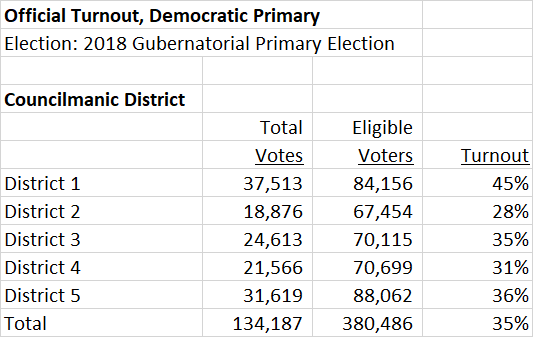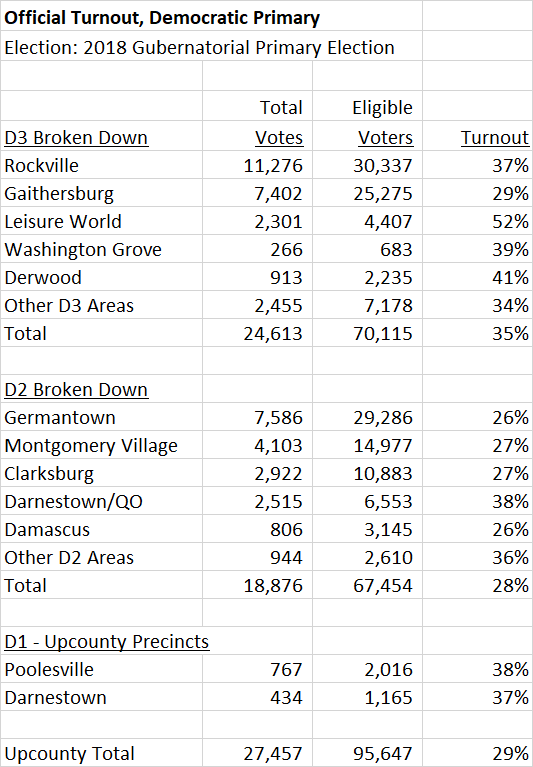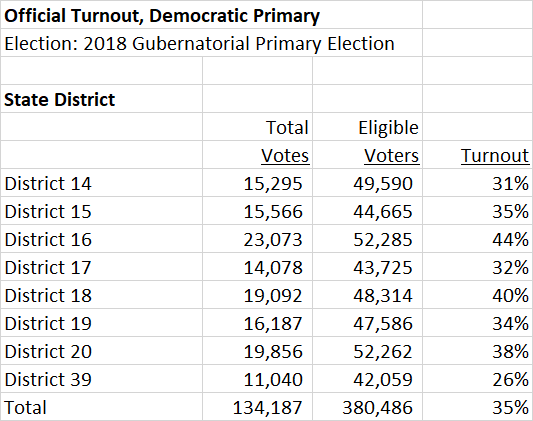By Marilyn Balcombe.
The premise of the petition drive by Nine Districts for MoCo is that the current structure of the Montgomery County Council does not allow for fair representation for residents in the Upcounty because seven of the nine Councilmembers live Downcounty. As it has been since 2006, all four At-Large Councilmembers live south/southeast of Rockville. The problem isn’t gerrymandered districts. The problem is voter apathy. The Upcounty simply does not vote at the same percentage as the County overall.
First the data.
The source of this data is the 2018 Gubernatorial Democratic Primary. For better or worse, local elections are decided in the Democratic primary and have been since 2006. Given the current party affiliations of registered voters in the county, changing the make-up of the County Council to nine district seats will not change that. If the reason behind the push for 9 district seats is geographic representation, we have to look at the Democratic primary to see why we are where we are and what we can do to change it. Focusing on the primary also underscores why it has been so difficult to change the paradigm.
Every 10 years councilmanic districts are redrawn to provide an equal number of residents for each district. Theoretically Upcounty Districts 2 and 3 should have as much say in any given election as Downcounty districts, such as District 1 in Bethesda or District 5 in Silver Spring and Takoma Park.
Granted, while each district starts off with the same number of residents, there are differences in the number of registered voters in each district. Regardless of the number of residents, the number and percentage of registered voters is lower in the Upcounty than in other areas of the County. There are also more Republicans and Independent voters in the Upcounty. The disparity in the total number of registered Democrats in the Upcounty makes a difference in the number of votes cast, but the fatal discrepancy is in the percentage of eligible Democrats who vote. Looking solely at turnout of Democratic voters, Council District 2 lags behind the rest of the County by 7 percentage points and significantly falls short of District 1 (Bethesda / Potomac) by 17 points.

The concept of Upcounty / Downcounty is an informal distinction with no true definition. As an Upcounty activist, I define the area to be North-Northwest of Rockville to include all of Council District 2, parts of D3 (Gaithersburg) and parts of D1 (Darnestown and Poolesville). The total Upcounty results are very similar to the D2 results with 29% of registered Democrats voting in the 2018 Gubernatorial Primary. Of course, the Upcounty isn’t monolithic. We have Poolesville and Darnestown areas voting at roughly 38% and the areas of Germantown and Montgomery Village with 28% voter participation rate. [NOTE: Election results are not reported by geographical area. The Upcounty breakdown data is based on individual precinct data aggregated for each of the areas identified.]

The same pattern is seen when looking at the State Legislative Districts. Upcounty District 39 continues to be the lowest voter turnout in the County, election after election. Historically, District 15 also had low voter turnout. However, in 2018 there was a contentious battle for an open Congressional seat and we saw a significant increase in voter participation in the district.

The Upcounty doesn’t vote and nobody cares.
I understand that is an inflammatory statement. However, the lack of voter turnout in the Upcounty is not new by any stretch. Council District 2 has had the lowest voter turnout, as has State District 39, as far back as I remember looking at the data. Every so often someone – myself included – will become outraged and try to light a fire of activism that quickly peters out. Unfortunately, there hasn’t been a systemic get out the vote (GOTV) effort in the Upcounty for the Democratic primary. There are 3 basic reasons why:
1. The current system works for everyone in power so there is no impetus for change. For candidates, including incumbents, it doesn’t really matter how many people vote. It just matters that you get the most votes. In every election I’ve ever seen, there is never enough time or money to reach every registered voter, let alone every potential voter. The most effective strategy is for candidates to reach out to the people who are most likely to vote – the “Super Dems” – which does not expand the voter base. In fact it perpetuates a small sliver of voters being responsible for determining our local elected body.
2. Similarly, candidates, including incumbents, go where the votes are. The first thing a candidate learns in How to Run for Office 101 is to know your number. How many votes do you need to win and where are you going to get the votes? If a higher percent of residents vote in the Downcounty, a candidate running At-Large will focus time and money in the geographic areas that turn out the most voters.
3. Another important factor is the role of the Democratic Party. Of course they want to increase voter participation, but their ultimate goal is to get Democrats elected in the general election. Because the primaries are partisan by design, the various democratic clubs don’t often actively engage in the primaries. While there may be some GOTV activity for the primary, the major push is for the general.
Does it really matter where the At-Large Councilmembers live if they still represent the whole County?
Yes. It’s a matter of representation which boils down to familiarity and exposure. As an active member of the community, a Councilmember is going to have a fluent knowledge of their own community much better than they do in other parts of the County – the schools, roads, parks, public safety, community structure, etc. In discussing transportation funding, it is so much easier for a Councilmember living in Silver Spring to understand the issues impacting Colesville Road than it is to fully understand the need for a road like M-83 – and if you had to look up what M-83 is, you proved my point. An At-Large Councilmember will continue to become more entrenched in their own community just by the nature of the geography. If there are a number of community events on a Saturday afternoon, it is much easier for a Councilmember who lives in Downcounty to hit three events in Silver Spring than come to events in Germantown. It’s also much easier for them to stop by an event on their way home from Rockville or drop by an event close to home between an early dinner and putting their kids to bed.
I’ve been working with At-Large members of the County Council for over 20 years in my job and in my community work. Through the years, some have done a much better job than others in being present and representing the Upcounty. I believe in the important role and function of the At-Large members of the County Council and do not advocate abolishing the At-Large seats, although I am intrigued by Adam Pagnucco’s recent blog post on increasing the number of geographic districts.
What’s the solution?
If the incumbents, candidates, and the party aren’t going to increase voter participation in the Upcounty, we need to take individual responsibility for our own representation and do what we can to get out the vote. Imagine if the time, effort and funding of the Nine Districts for MoCo initiative was spent registering Upcounty voters, educating those already registered about the importance of the gubernatorial primary in Montgomery County, and then working – as hard as they are working now – to actually Get Out The Vote on primary election day. If every person who signed the Nine Districts petition made it a personal goal to increase voter participation in the Upcounty, we could make it happen.
Looking again to the 2018 primary, if the Upcounty turnout was the same as the County’s overall average, we would have had 6,000 more votes in the Upcounty. That most likely wouldn’t have changed the results of the At-Large race. However, if the Upcounty turnout was the same as the average turnout for District 1, we would have had almost 16,000 more votes which most likely would have. At the very least it would tell future candidates that the Upcounty matters.
Marilyn Balcombe is a resident of Germantown who ran for County Council At-Large in 2018.
